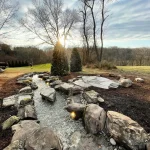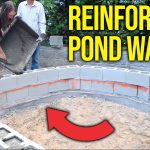Adding a large pond waterfall to your outdoor space can transform it into a tranquil and visually stunning oasis. The sight and sound of cascading water can create a soothing ambiance and attract wildlife, making your pond a focal point of your landscape. With the right planning and execution, you can create a breathtaking water feature that enhances the beauty of your property. In this guide, we’ll walk you through the step-by-step process of building a large pond waterfall that will elevate the aesthetics and functionality of your outdoor environment.
Step 1: Planning and Design
Before you start digging or purchasing materials, it’s crucial to carefully plan and design your pond waterfall. Consider the size and shape of your pond, the desired location of the waterfall, and how it will integrate with the existing landscape. Take into account the natural slope of the land and determine the best placement for the waterfall to achieve a natural-looking flow of water.
Sketch out your ideas on paper or use a digital design tool to visualize the layout of the waterfall. Think about the overall aesthetic you want to achieve – whether it’s a gentle, meandering stream or a dramatic, cascading waterfall. Consider the types of rocks and vegetation you want to incorporate to enhance the natural look of the feature.

Credit: aquaticgarden.com
Step 2: Gathering Materials and Tools
Once you have a clear plan in place, it’s time to gather the necessary materials and tools for the project. You’ll need a variety of rocks and stones of different shapes and sizes to create the natural-looking facade of the waterfall. Additionally, you’ll require a pond liner, a submersible pump, flexible tubing, and a reservoir for the water to collect at the base of the waterfall.
Other essential tools include a shovel, a wheelbarrow, a level, and a hose. Depending on the complexity of your design, you may also need a masonry saw, mortar, and other landscaping tools. Ensure that you have all the required materials and tools on hand before you begin construction to avoid delays and interruptions.

Credit: www.youtube.com
Step 3: Excavation and Placement
Start by marking the outline of the waterfall and excavation area with spray paint or stakes and string. Use a shovel to dig out the designated area for the waterfall, making sure to create a gradual slope to guide the water flow. As you dig, periodically check the level of the ground to ensure that the slope is consistent and will facilitate the natural movement of water.
Once the excavation is complete, position the pond liner in the designated area, ensuring that it extends beyond the edges of the excavation site. The liner will help contain the water and prevent leakage. Secure the liner in place with rocks or other heavy materials to keep it from shifting during construction.
Step 4: Creating the Waterfall Structure
With the excavation and liner in place, it’s time to start building the structure of the waterfall. Begin by arranging the rocks and stones in a natural-looking formation, taking care to vary the sizes and shapes to create an organic, textured appearance. Use the largest rocks as the foundation and gradually build up the structure, ensuring that each rock is securely positioned to withstand the force of the water flow.
If you’re incorporating a stream into your waterfall design, use the flexible tubing to create a channel for the water to follow. Conceal the tubing with rocks and ensure that it is positioned to guide the water along the desired path. As you build the structure, periodically test the water flow to ensure that it follows the intended course and creates the desired visual and auditory effect.
Step 5: Installing the Pump and Water Reservoir
Once the waterfall structure is in place, it’s time to install the submersible pump and connect it to the flexible tubing. The pump will circulate water from the reservoir to the top of the waterfall, creating a continuous flow. Position the pump in the reservoir and connect it to the tubing, ensuring a secure and watertight seal.
Fill the reservoir with water and test the pump to ensure that it effectively circulates water to the top of the waterfall. Adjust the flow rate as needed to achieve the desired water movement and sound. Conceal the reservoir with rocks and vegetation to create a seamless and natural-looking transition from the waterfall to the collection basin.
Step 6: Finishing Touches and Landscaping
With the waterfall and water circulation system in place, it’s time to add the finishing touches and integrate the feature into the surrounding landscape. Consider planting native vegetation around the waterfall to enhance its natural appeal and create a harmonious transition between the water feature and the rest of your outdoor space.
Use mulch and gravel to conceal the edges of the pond liner and create a polished, cohesive look. Consider adding accent lighting to highlight the waterfall and extend its visual impact into the evening hours. Finally, take the time to step back and admire your handiwork, making any final adjustments to ensure that the waterfall complements the overall aesthetic of your outdoor environment.
Step 7: Maintenance and Care
Once your large pond waterfall is complete, it’s important to establish a regular maintenance routine to keep it in optimal condition. Regularly inspect the pump, tubing, and reservoir to ensure that they are functioning properly and remain free of debris and blockages. Remove any accumulated leaves, twigs, or other organic matter from the waterfall structure to maintain optimal water flow and prevent clogs.
Monitor the water quality and clarity of the pond to ensure a healthy environment for any fish or plants that may inhabit the water feature. Consider adding a biological filter or other water treatment solutions to maintain balanced water chemistry and prevent the growth of algae and other unwanted organisms.
By following these steps and investing time and effort into the planning, construction, and maintenance of your large pond waterfall, you can create a stunning and enduring focal point for your outdoor space. Whether you’re seeking a peaceful retreat for relaxation or a captivating element to enhance your landscape, a well-designed and well-maintained waterfall can elevate the beauty and ambiance of your property for years to come.




